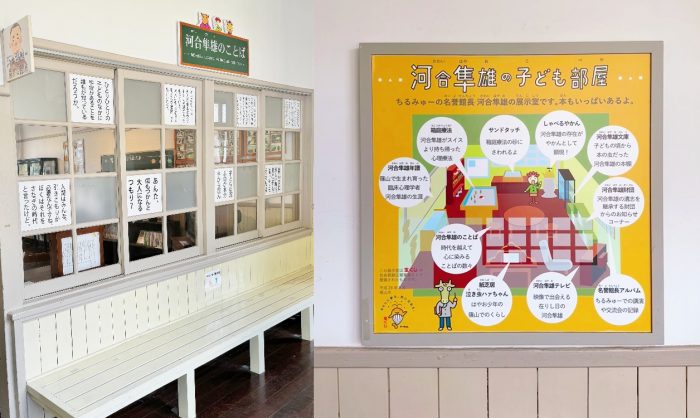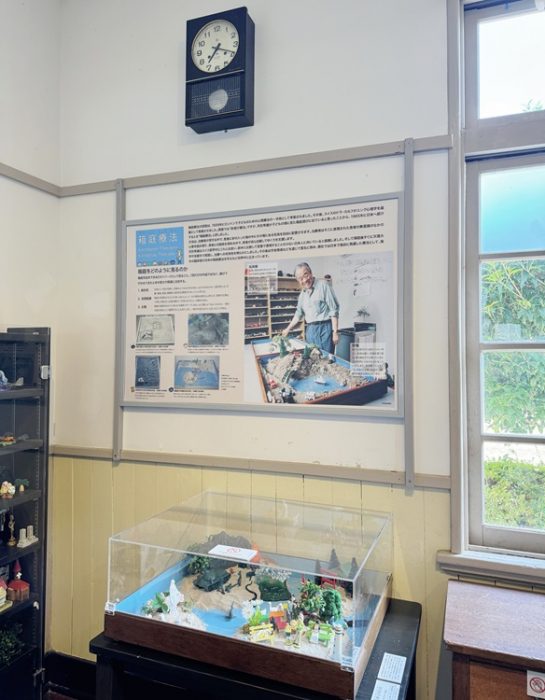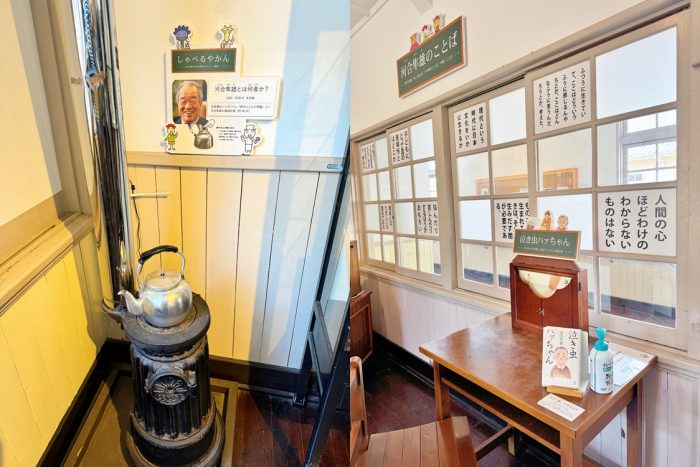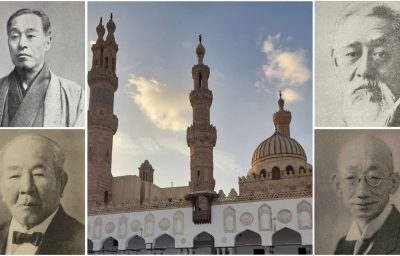COMMUNICATIONS
Following in the Footsteps of “Crybaby Hā-chan”
The World of Kawai Hayao as Encountered in Tamba Sasayama
One fine weekend in August, I accompanied Professor Yasui Manami on a trip to Tamba Sasayama to do fieldwork on folk medicine. Our guide at the time was Inada Ken’ichi, who once worked as an acupuncturist in thetown. When Mr. Inada was planning the trip, he proposed we go and visit “an extremely interesting museum with a special connection to Nichibunken.”
And so it was that we ended up at the Sasayama Children’s Museum in Tamba Sasayama, which might just be the cutest museum I have ever seen. It stands on the site of Taki Middle School; buildings abandoned when the school was merged were repurposed as a museum for children. There are display rooms with different themes. The museum helps children understand children’s cultures in Japan and other countries. Its participatory entertainment rooms foster within them a curiosity towards nature and the wider world. One such room was our destination on this occasion, “Kawai Hayao’s Children’s Room.”

Guide to the “Kawai Hayao Children’s Room” at the Sasayama Children’s Museum; (photo by the author)
Kawai Hayao (1928-2007) was a Kyoto University graduate and famous psychologist. In 1962, he became an assistant professor at Tenri University, and then studied abroad at the C.G.Jung-Institut in Zurich. He was the first Japanese to qualify as a Jungian psycho-analyst. He subsequently established Jungian psychology in Japan, and became a preeminent scholar for matters of the mind. In 1965, Kawai introduced “sand-play therapy” from Switzerland into Japan. He translated it as“Hakoniwa Ryōhō”, literally “box-garden therapy,” which has an East Asian cultural ring to it. It duly acquired popularity in China, Korea, and other countries, too. From 1972, Professor Kawai began to teach at the Education Department of Kyoto University. He also held a joint professorial appointment at Nichibunken from its foundation in 1987, and from 1995 to 2001, he contributed enormously to Nichibunken’s development as its second director.

Box-garden therapy display (photo by the author)
Tamba Sasayama was Professor Kawai’s birthplace, which is why in September 2017 the Sasayama Children’s Museum opened the “Kawai Hayao Children’s Room.” Professor Kawai had after all served as the museum’s honorary director. The museum introduces this display room with the question: “What sort of child was the late Kawai Hayao, the museum’s honorary director?”
The museum is an old school building, so the room is permeated with the simple warmth of the Shōwa period. The old polished wooden floor, comfortable desks and chairs, warm sunlight streaming in through the milky white bars on the window: all this is designed to usher the visiting children into Professor Kawai’s childhood. It is a small room, but there are ten ample displays. The walls provide an introduction to Professor Kawai’s life, as well as fascinating recollections written by his friends. Scattered here and there on window bars are Professor Kawai’s aphorisms resonating across the ages.
One display in the room is of “box garden therapy,” which features a purpose-built sandbox and a set of toys. Opposite this is a bookshelf featuring books authored by Professor Kawai, as well as books he loved as a child. In one corner is a fascinating item, the “shaberu yakan” (talking kettle). Push the lid, and you can listen to one of Professor Kawai’s lectures. In the opposite corner stands a “Kawai Hayao TV,” where you can watch his TV appearances. Sitting on the comfortable sofa, you can encounter Professor Kawai from many years past. By the museum entrance, there is a truly nostalgic participatory display. It is a series of picture-story cards, based on Professor Kawai’s posthumous work of “Nakimushi Hā-chan” (Crybaby Hā-chan). It is possible for adults, too, to return to their childhood here, and participate with Professor Kawai in many of his fascinating childhood experiences.

The “talking kettle” and a picture-story version of “Crybaby Hā-chan.” (photo by the author)
After returning from Tamba Sasayama, I read “Crybaby Hā-chan,” and reflected on my visit. To read the words of Professor Kawai is to conjure up Tamba ’s beautiful landscape. The model for the protagonist, Hā-chan, was none other than Professor Kawai himself. This book is a moving reflection from the end of his life on ages past; it was his final gift to children. Hā-chan inhabits a world of joy and sorrow, courage and cowardice, strength and weakness, comfort and loneliness; in short, the book abounds in delicate emotions. Its realism and immediacy are astonishing.
When I read these beautiful stories, it is as if I am transported back to that small museum. I feel that Professor Kawai, smiling warmly, is enjoying an amble. He keeps watch on the children as they rush around, but he watches, too, over the hearts of children everywhere and, indeed, over those “grown-up children,” who never let go of the hearts they had as children.




